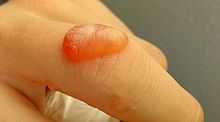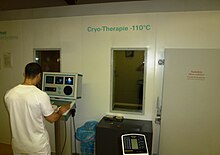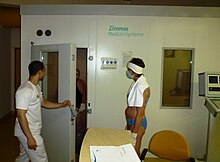Cryotherapy

As cryotherapy (ancient Greek κρύος kryos, German, ice, frost ') or cold therapy refers to the selective use of cold stimuli to cause a therapeutic effect. A distinction is made between the local application of cold (mostly using specific media such as cold packs as part of physical therapy or liquid nitrogen for cryosurgery) and generalized cold treatment of the whole body (usually without skin contact as in cold air therapy or in the cold chamber).
Tissue damage from exposure to cold is an undesirable effect of cryotherapy (a desirable effect in cryosurgery).
Cold therapy as part of physical therapy
This form of cryotherapy is by far the most common area of application of the targeted application of cold for therapeutic purposes. Cold therapy is used as a sub-area of thermal therapy in the context of physical therapy. This involves both local (mostly with skin contact) and generalized (without skin contact) cold therapy, which, according to the current therapeutic products guidelines , can be partially assigned to certain prescription measures.
Various methods are used, which differ in temperature and place of application (for example ice compresses, ice packs, changing mats with different media, ice immersion, cold water, etc.). In addition, when it comes to therapeutic use of the cold stimulus, a distinction is made between short-term use (approx. 10–15 minutes) and long-term use (approx. 1–2 hours).
A significant area of application is the treatment of inflammatory processes with the classic signs of inflammation of overheating , redness , swelling and pain . A moderate application of cold has both anti-inflammatory and analgesic effects . This complex application of the cold stimulus is used in the context of non-drug anti-inflammatory therapy, for example in rheumatology .
Cold chamber
With the generalized application of cold in a cold chamber , whole body cold therapy (GKKT), a patient is exposed to a temperature of around −110 ° C for a few minutes. This is intended to influence metabolic processes at the cellular level. A large number of diseases are indicated as areas of application, in particular the group of rheumatic diseases , but also from the psychiatric area (such as fear, panic attacks and sleep disorders). The effect of the method is controversial, despite various positive studies, no detailed studies are available. Athletes use cryotherapy to prevent sore muscles. During this application, the outer parts of the body must be protected from frostbite ( acre protection ). Since the positive effect of cold therapy lasts for about three hours, it was also used in training camps before the intensive training load (at −120 to −150 ° C). While creatine kinase as an indicator of physical stress rose by 250% without cold therapy , it was only 13% with cold therapy. One of the explanations for this seems to be that cryotherapy stimulates the body's own testosterone release when it is cold enough.
cryosurgery
As a local procedure, also known as cryosurgery , freezing techniques with very low temperatures are used in order to destroy pathologically altered tissue. A distinction is made between closed processes, in which a cold probe is brought into contact with the tissue from the outside, and open processes, in which coolant is introduced directly into the tissue (often liquid nitrogen at −196 ° C). The working range is −70 ° C to −200 ° C. Such procedures are used in dermatology to remove tumors, warts (viral papillomas), excessive scar tissue ( keloid ) and various other tissue diseases . In addition, cryosurgery is also used in interventional therapy procedures for other tumors, such as for the treatment of liver metastases and possibly lung or prostate tumors.
Other uses
In addition to these methods, the application of cold is used in many other areas of medicine, such as rheumatology , pain therapy and intensive care methods such as therapeutic hypothermia and for diagnostics as cold provocation tests . The last-mentioned methods, however, work with a far lower cooling effect than in cryosurgery or in the cold chamber. In dentistry, a portion of about 0.1 cm 3 of carbonic acid snow is pressed against the side of a tooth by means of a pen in order to test the functioning of the tooth nerve.
See also
- Whole body cryotherapy
- Cryoablation in cardiology
- Cryoextraction of the lens of the eye in ophthalmology
- Cryostripping in Angiology
- Cold burn
Individual evidence
- ↑ Badde-Borcherding E et al .: Physical therapy, massage, electrotherapy and lymphatic drainage . Georg Thieme Verlag, 2006.
- ↑ Heisel J .: Physical Medicine . Georg Thieme Verlag, 2005.
- ^ Hettenkofer HJ: Rheumatology: Diagnostics, Clinic and Therapy . Georg Thieme Verlag, 2003.
- ^ Ice Bath Treatment for Anxiety. ( Memento of the original from January 13, 2013 in the Internet Archive ) Info: The archive link was inserted automatically and has not yet been checked. Please check the original and archive link according to the instructions and then remove this notice. on: articlesnatch.com
- ^ Ice Bath Benefits. on: icebath.org , 2011.
- ↑ M. Krasuski, P. Tederko: Cryotherapy in contemporary rehabilitation: a review. In: Ortop Traumatol Rehabil. 7 (1), Feb 28, 2005, pp. 60-65. PMID 17675958
- ^ A. Wozniak, C. Mila-Kierzenkowska, M. Szpinda, J. Chwalbinska-Moneta, B. Augustynska, A. Jurecka: Whole body cryostimulation and oxidative stress in rowers: preliminary results. In: Arch. Med. Sci. 9 (2), 2014, pp. 303-308.
- ^ Arnd Krüger : Whole body cold therapy. In: competitive sport. 44 (5), 2014, pp. 25-26.
- ↑ Cryosurgery in Dermatology. (PDF; 357 kB): Recommendations of the German Dermatological Society (DDG), online at AWMF
- ↑ W.-I. Worret, H.-J. Vogt: Scar therapy in dermatology . In: Dtsch. Doctor bl. 101, issue 42, 2004, pp. A 2819-2824.
- ^ JK Seifert, A. Springer, P. Baier, T. Junginger: Liver resection or cryotherapy for colorectal liver metastases: a prospective case control study. In: International Journal of Colorectal Disease . 20 (6), Nov 2005, pp. 507-520. PMID 15973545 .
- ↑ M. Shelley, TJ Wilt, B. Coles, MD Mason: Cryotherapy for localized prostate cancer. In: Cochrane Database Syst Rev. (3), Jul 18, 2007, Art. No. CD005010. PMID 17636783


